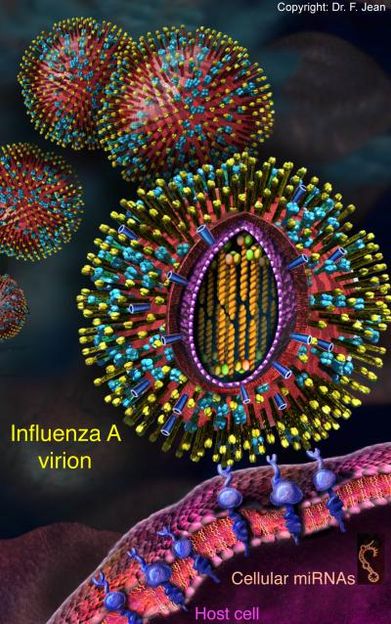Genetic regulators hijacked by avian and swine flu viruses identified: UBC study
Researchers at the University of British Columbia have identified a number of tiny but powerful "genetic regulators" that are hijacked by avian and swine flu viruses during human infection.

This is an illustration showing the influenza A virus, host cell, and cellular microRNAs.
Professor Francois Jean, University of British Columbia
The discovery, published in the Journal of Virology, could reveal new targets for broad-spectrum antivirals to combat current – and perhaps future – strains of influenza A viruses.
The study is the first to compare the role played by human microRNAs – small molecules that control the expression of multiple genes – in the life cycle of two viruses of continued concern to public health officials around the world.
"We know that microRNAs are implicated in many types of cancers and other human diseases, but focusing on microRNA signatures in viral infection breaks new ground," says François Jean, Associate Professor in the Department of Microbiology and Immunology and Scientific Director of the Facility for Infectious Disease and Epidemic Research (FINDER) at UBC.
The study discovered two largely distinct sets of microRNAs involved in pandemic (2009) swine-origin H1N1 virus and the highly pathogenic avian-origin H7N7 strain, with only a small subset of microRNAs involved in the regulation of both infections.
"Host-virus interplays are certainly complex, but our discovery points to a new level of cross-communication between viruses and the human cells in which they reproduce," notes Jean. "The finding that a significant number of these microRNAs are transported in microparticles – known as exosomes –involved in intercellular communication is also very exciting. It raises the question as to what role these exosome-associated regulators may play in the onset and spread of the flu virus."
Jean believes that the discovery of the unique microRNA signatures associated with pandemic and deadly flu viruses will assist in developing antiviral treatments that don't run the risk of increasing drug resistance. "Future research on microRNAs could help us develop novel antiviral treatments, adding desperately needed drugs to our current therapeutic repertoire against upcoming flu pandemics."
Most read news
Organizations
Other news from the department science

Get the life science industry in your inbox
By submitting this form you agree that LUMITOS AG will send you the newsletter(s) selected above by email. Your data will not be passed on to third parties. Your data will be stored and processed in accordance with our data protection regulations. LUMITOS may contact you by email for the purpose of advertising or market and opinion surveys. You can revoke your consent at any time without giving reasons to LUMITOS AG, Ernst-Augustin-Str. 2, 12489 Berlin, Germany or by e-mail at revoke@lumitos.com with effect for the future. In addition, each email contains a link to unsubscribe from the corresponding newsletter.




















































